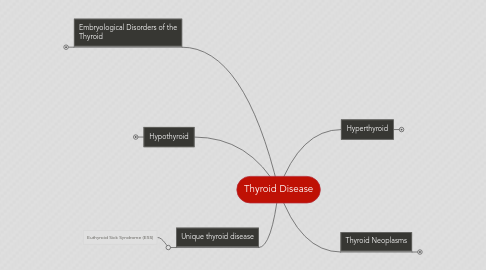
1. Hyperthyroid
1.1. Presentation:
1.2. Differential Dx:
1.2.1. Grave's Disease
1.2.1.1. autoimmune disease. Most common cause of hyperthyroidism and thyrotoxicosis in the USA. Mostly females get this disease. HLA-B8 and HLA-DR3 associated disorder. (get familial clustering SLE, PA, DM1, and Addison's)
1.2.1.2. Pathogenesis: T-cells induce specific B cells to produce IgG autoantibodies against the TSH receptor on the thyroid. This is a stimulating autoantibody! Making this also a Type II Hypersensitivity rxn. (antimicrosomal and antithyroglobulin are seen). The disease may be brought on by infection, withdrawal of steroids, iodide excess, post-partum.
1.2.1.3. Presentation: symmetrical, nontender thyromegaly. Infiltrative opthalmopathy (exopthalmos; 50% of pts)- proptosis and muscle weakness of the eye [due to adipose and glycoaminoglycans deposited in the orbital tissue], Pretibial myxedema (excess glycosaminoglycans in the dermis), Digit swelling and clubbing fingers, nails separate from nail bed
1.2.1.4. Unique: IgG against TSH can cross the placenta and cause hyperthyroidism in the fetus! Also in the elderly, we should worry about atrial fibrillation, congestive heart failure, muscle weakness, and apathy.
1.2.1.5. Treat: beta blockers, thionamides to decrease hormone synthesis (methimazole and propylthiouracil), Radioactive Iodine (131) for one year if other treatments do not work.
1.2.1.6. Histological: columnar, paillary epithelial hyperlasia, scalloping & depleted colloid (not diagnostic but consistent w/ dx), lymphoid infiltrates (germinal centers formed). Papillary projections in the follicular lumen.
1.2.2. (Plummer syndrome)Toxic multinodular goiter
1.2.3. Toxic adenoma
1.2.4. DeQuirvan's Thyroditis (subacute granulomatous thyroiditis)
1.2.5. RARE:
1.2.5.1. Pituitary or Hypothalamus dysfunction
1.2.5.2. *rare, functioning thyroid carcinoma
1.2.5.2.1. most carcinomas are "cold' producing no T4 or T3 and will NOT take up radioactive Iodine.
1.2.5.3. Gestational neoplasia and non-gestational choriocarcinoma (producing hCG)
1.2.5.3.1. hCG cross reacts with TSH receptors and causes hyperthyroidism.
1.2.5.4. Stuma ovarii
1.2.5.4.1. Thyroid tissue on the ovary.
1.3. Treatment
1.3.1. Inhibit hormone synthesis: propylthiouracil (PTH) for pregnant women, Iodide, Sympathetic block w/ beta blockers, hydrocortisone, cooling blanket
1.4. Thyroid Storm
2. Hypothyroid
2.1. Presentation: "slow start" fatigue (decreased ability/motivation for physical and mental work), decreased appetite, loss of outer 1/3 of eyebrow, increased weight gain (hypometabolic state and salt/water retention), mental slowing, cold intolerance, muscle aches, HYPERcholesterol, constipation, dry skin, menstrual cycle longer/heavy, hair loss, bradycardia, course yellow skin (less conversion of beta carotenes into retinoic acid), slowed relaxation phase reflex, hoarseness, edema (around eyes due to increased hyaluronic acid in the interstitial tissue- absorbs water), w/ or w/o goiter.
2.2. Differential Dx:
2.2.1. Acquired (adults and children)
2.2.1.1. Thyroiditis
2.2.1.1.1. Hasimoto's Thyroiditis (autoimmune)
2.2.1.1.2. Subacute/acute (uncommon)
2.2.1.1.3. Riedel's Fibrosing Thyroiditis (chronic sclerosis thyroiditis, struma fibrosa, ligneous thyroiditis)
2.2.1.2. Surgery/radiation (in Hx)
2.2.1.3. After radioactivie iodine treatment for hyperthyroidism (in Hx)
2.2.1.4. Drug-induced (amiodarone, lithium, iodine salts, sulfonamides, and phenylbutazone) (in Hx)
2.2.1.5. Iodine Deficiency (in at risk parts of the world) (in Hx)
2.2.1.6. Hypopituitarism/Hypothalamic dysfunciton
2.2.1.7. Thyroid peroxidase deficiency
2.2.2. Congenital (infants/children)
2.2.2.1. Congenitial absence of the thyroid or Congenital defects in thyroid hormone synthesis
2.2.2.1.1. Cretenism
2.3. Treatment
2.3.1. Levothyroxine (T4)
2.3.1.1. MOA: synthetic hormone, peripheral activation to T3. Acts on mitochondria and alters gene expression.
2.3.1.2. Clinical Use: hypothyroid (hormone replacement), thyroid cancer (suppress TSH), myxedma coma
2.3.1.3. Problems: Excess dosing causes hyperthyroidism, can exacerbate acute MI
2.3.1.4. Unique: full replacement dose is 1.6 mcg/kg/day but less when concerned about cardiac risks (known heart disease, elderly), it takes a while to work b/c T1/2= 7days (have patients come back after 5-6weeks for a TSH reading). B/c of the long half-life, it's okay to make up for missed doses.
2.3.1.5. Administration: take on an empty stomach (food, calcium or iron, low acidic environments can inhibit absorptions), increased requirement w/ oral estrogen (because OC, tamoxifene, HRT increases thryoid bingind globulin), increased requirement w/ SSRIs (accelerates metabolism).
2.3.2. High Dose corticosteriods
